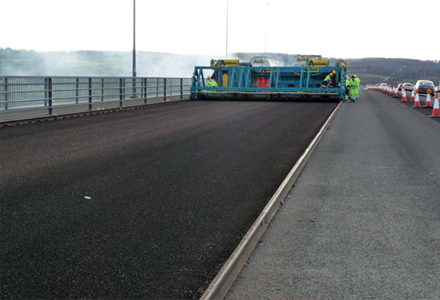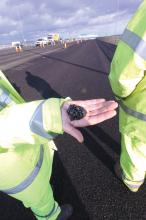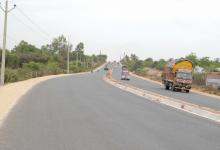Bitumen has been used for thousands of years, but now a wide variety of products are available that can be added to it to produce blends with improved properties. According to the Refined Bitumen Association (RBA) bitumen is the oldest known engineering material. Indeed, the organisation says that its versatility as a construction material is unparalleled, and having been used as an adhesive, sealant and waterproofing agent for over 8,000 years, its uses include the construction and maintenance of roads, ai

RSS
While natural bitumen does occur, the vast majority of bitumen used by today's construction industry is refined bitumen, derived from crude oil.
"It is a sophisticated product available in many forms and grades developed by the bitumen industry for specific uses. The process of refining bitumen was pioneered in the early 1900s in the United States, giving rise to a myriad of contemporary industrial applications," says the RFA.
Bitumen, a product derived from distillation of crude oil, is made from part of the residue left over after gas oil has been drawn off from the bottom of a distillation column. After further processes different grades of bitumen are produced and rated according to a 'penetration test', utilising a needle under a specified load which measures the extent to which the needle sinks into a test sample.
Bitumen can be modified or given specific qualities by further processes, and these include blowing air through the bitumen mix to give it higher viscosity and greater resistance to softening (particularly for road applications), and secondary processes involving specially developed additives or emulsifying with water. Companies such as1161 BP Bitumen, 184 Colas, ExxonMobil, Iterchmica, 715 Kraton Polymers, Lake Trinidad Asphalt, 6805 Massenza, 294 Nynas, 763 Shell Bitumen, 344 Total Bitumen and 360 VSS Macropaver are among those developing products.
One such additive is Nypol 45MA, one of a new generation of premier polymer modified binders (PMBs) from Nynas, which was used in a mix on the 1.4km long Avonmouth Bridge on the M5 motorway near the city of Bristol, south-west England, the highway's most important crossing, carrying some 120,000 vehicles/day high over the River Avon. The bridge has 400m of central sections and 17 approach spans (ten to the north, seven to the south) in reinforced concrete.
In normal use, it provides four lanes in each direction plus a narrow central reserve, hard shoulders, a pedestrian walkway and a cycle way, but by 2006 the bridge needed a new asphalt surface. According to the1441 UK Highways Agency (HA) its steel central and anchor spans "displayed significant movement." The crossing's asphalt surfacing has a tendency to wear out relatively rapidly and requires frequent maintenance. It was resurfaced around the turn of the millennium.
The HA, determined to find a surfacing that would provide long life, require minimum intervention during that life, resist water penetration and offer early life skid resistance, started a remarkable journey involving a number of companies including pan-European bitumen specialist Nynas.
The agency wanted something that would work, last and provide a decent return on its money (around £7 million/US$10 million per carriageway), so its agents scoured the world and in Switzerland talked to Aeschlimann International, the company that (in collaboration with others) surfaced Denmark's Storebaelt bridge, Europe's largest crossing.
Heinz Aeschlimann, charismatic head of the asphalt specialist, took up the Avonmouth challenge, claiming that his gussasphalt material (very dense mastic asphalt as opposed to hot rolled asphalt or stone mastic asphalt, other materials put under the microscope by the HA) will last from 20 to 30 years.
Work on the southbound deck began last September and is now completed, although vehicles continue to bump and clatter over the northbound deck, on which work is scheduled to start this September (completion set for January 2010).
Client for the Avonmouth project is the Highways Agency; acting on its behalf is InterRoute (joint venture of2579 Mott MacDonald and 1146 Balfour Beatty Infrastructure Services), the service provider under the local (Area 2) EMAC (enhanced managing agent contract), which placed a bridge deck waterproofing and resurfacing contract with 2314 Stirling Lloyd, and it turned to Aeschlimann International for its gussasphalt. That company chose 2644 Hanson, operating out of its local Tytherington plant, to produce the gussasphalt, which was designed by Heinz Aeschlimann and mixed to his exacting specification and subject to his personal quality control. Nominated as a supplier was Nynas, whose products and Swiss facilities are also well known to Aeschlimann.
Its Nypol 45MA PMB is purpose-designed for specific applications and is a high performance binder particularly well suited to the kind of asphalt mixes designed by Heinz Aeschlimann.
Helping Hanson get its asphalt supply contract was the fact that it had a new167 Benninghoven mixing plant installed at Tytherington, which could be turned over to producing the high-tech Swiss material.
Details of the Aeschlimann mix for the bridge have not been formally released but it is known that a blend of sands, a very high proportion of limestone filler and a number of additives including Trinidad Lake Asphalt granules (see separate story/Road Technology Live at ConExpo 2008), along with the Nypol 45MA, go into making the gussasphalt for the bridge's binder and surface courses.
Previously the steelwork was surfaced in hand-applied mastic asphalt while the concrete decks had received hot rolled asphalt, but now all the surfacing is with Aeschlimann's gussasphalt. Surface and binder course add up to 50mm thick on top of the steel, 60mm on the concrete.
The material is delivered on site at over 200oC in mobile gussasphalt cookers (it can remain workable for up to 24 hours), and is merely dropped in front of the gussasphalt finisher between rails, which can be positioned up to 15m wide to suit circumstances. The finisher spreads the gussasphalt and (in the case of the surface course) immediately grits the new surface. A rolling system patented by Aeschlimann is then applied, to bed in the grit. No other compaction is required.
Prior to the work the old waterproofing had to be removed, and proved no easy task. Stirling Lloyd's original Eliminator bridge deck waterproofing has worked well and has not deteriorated since first applied. Proving difficult to take up it was replaced by more of the same.
This was followed by resurfacing itself and reinstatement of the central reservation barrier, bearing in mind that the HA specified that InterRoute keep three lanes open in each direction during resurfacing.
HA's project sponsor Dave Stock, said: "The gussasphalt ticks all the right boxes, including assured longevity, the likelihood of minimal intervention, resistance to water penetration, early life skidding resistance, good ride quality and relatively low noise." [This was compiled from a fuller story supplied by Nynas which can be found at www.worldhighways.com].
Jim Wright of AkzoNobel said that the first large job using Rediset was carried out in Texas, US, and the product has been trialled in Europe by Norwegian contractor1209 Veidekke. [This company in collaboration with Shell Bitumen developed and trialled in Norway WAM-Foam, a brand new technology to reduce the emissions during asphalt mixture manufacturing and laying. See 3260 World Highways November/December 2000].
"We have done numerous trials, and it is estimated that there is an approximate 20% saving on fuel costs just in the asphalt manufacturing process.
"There are savings all the way through the train because you can compact it easier and with fewer passes. The material is also less sticky so it is easier to clean off the trucks and the roller drums. The material can be transported further and is less sensitive to low temperatures. It extends the paving season."
The Rediset system is said to enable the production of hot mix up to 30°C lower temperature than normal hot mix, reducing fuel consumption by at least 20% and significantly lowering CO2 emissions.
The dosage is 2% of the bitumen or about 1kg per tonne mix, and the hot mix plant does not have to be modified.
Rediset WMX is said to maintain the PG grading of the bitumen used and in some cases it can enhance the low temperature flexibility of bitumen while improving cohesive strength of the bitumen and thereby reduces rutting and moisture sensitivity of the mix and in the final pavement.
According to AkzoNobel Rediset is formulated to improve the adhesion between the aggregate and the bitumen and thereby prolong the service life of the road and reduce the maintenance needed during its life time.
TLA, used on highways, bridge decks, tunnels, airports and sea terminals, was previously supplied to customers in drums and blended with refinery bitumen in appropriate proportions (typically 25-40%) and specialised equipment was required for its preparation and use.
But last year at the ConExpo show in the USA, the company announced that in future the product would be supplied only in pellet form thus replacing the need for the specialised equipment and offering wider end-use applications.
The basic properties of TLA are a penetration at 25°C of 1-4; specific gravity at that temperature of 1.4 and a sofening point (R&B) of 93-98.
TLA claims that the advantages of its product are an increased life cycle of pavement (up to 2.5 times regular bitumen); reduced rate of ageing (and a reduction of the related problems associated with ageing); increased stability, and improved anti-skid properties.
While TLA has traditionally been a proven binder stiffening additive to enhance pavement load bearing properties and prevent rutting and wear and tear to reduce pavement maintenance and prolong pavement life, it is now also in a "proven" warm mix technology.
The company says that TLA-X warm mix technology has been specially developed to deliver the same benefits but in lower temperature paving warm mix mode.
Sasobit is said to offer an alternative to SBS (styrene-butadiene-styrene) modification when increased stiffness to prevent rutting is required, says Brian D. Powell in his paper Binder Modification with Sasobit. SBS is an elastic polymer commonly used as a modifier in
the United States.
According to Powell there is currently a shortage of butadiene and a shortage of SBS modfied binder results from this, although Sasobit can be added in combination with SBS (potentially lower dosage) to produce a binder which is stiff, but also offers some of the elastic benefits of SBS.
He says in the paper that Sasobit has been successfully used with reclaimed asphalt pavement (RAP) where the aged binder in Rap stiffens the binder in the new mixture, and Sasobit also offers the advantages of a warm mix asphalt additive including improved compaction and the possibility for reduced emissions.
701 Dupont also offers a number of solutions for highway product applications and these include its Elvaloy RET (reactive elastomeric terpolymer) resin and Entira® Bond for SBS binders.
The company says that added in small quantities to asphalt, Elvaloy terpolymer creates a permanently modified binder with improved elastomeric properties.
"Unlike most other plastomers and elastomers that are simply mixed into asphalt, Elvaloy has an active ingredient that chemically reacts with asphalt. The result is not a mixture of asphalt and modifier, but rather a stable, elastically improved, more resilient binder that can be stored and shipped to hot mix plants to help meet SHRP (US Strategic Highway Research Program) and other higher-performance specifications.
"Hot mix asphalts made with Elvaloy are easy to spread and compact, and provide outstanding resistant to rutting, cold cracking and fatigue. Roads made with Elvaloy have been in service since 1991, and are showing excellent long-term durability."
Indeed, the product was used during paving of the Manali-Leh road leading to the Ladakh Valley in Kashmir, said to be one of the most remote regions on earth, although each year the 680m high desert located along the Himalayan belt in northern India draws thousands of visitors a year, including mountaineers, explorers, and tourists.
Most arrive by air in Ladakh's capital, Leh, but the 480km Manali-Leh highway now offers an option in the summer months for visitors to access the highway from Manali, the Indian gateway city to the Himalayas located in the northern state of Himachal Pradesh. The highway climbs to a height of 5,600m at the Khardungla Pass, making it the highest motorable road in the world. Elvaloy has been tested as a superior polymer by FHWA in the US and is used commercially all over the World.
DuPont's Entira Bond is related to Elvaloy RET chemistry and is compatible with SB (styrene/butadiene) and SBS polymer systems for asphalt rutting, fatigue and cold temperature performance.
According to the company, Entira Bond can be added after SB/SBS polymer high-shear mill [a blending method], "potentially boosting polymer modified asphalt capacity."
It says that only minor equipment modifications are necessary to add Entira Bond to current mixing systems. Incorporation to the PMB can be done in the same equipment or using a simple top down agitator in a different location.
RSS
Bitumen has been used for thousands of years, but now a wide variety of products are available that can be added to it to produce blends with improved properties
According to the Refined Bitumen Association (RBA) bitumen is the oldest known engineering material. Indeed, the organisation says that its versatility as a construction material is unparalleled, and having been used as an adhesive, sealant and waterproofing agent for over 8,000 years, its uses include the construction and maintenance of roads, airfields and many others.While natural bitumen does occur, the vast majority of bitumen used by today's construction industry is refined bitumen, derived from crude oil.
"It is a sophisticated product available in many forms and grades developed by the bitumen industry for specific uses. The process of refining bitumen was pioneered in the early 1900s in the United States, giving rise to a myriad of contemporary industrial applications," says the RFA.
Bitumen, a product derived from distillation of crude oil, is made from part of the residue left over after gas oil has been drawn off from the bottom of a distillation column. After further processes different grades of bitumen are produced and rated according to a 'penetration test', utilising a needle under a specified load which measures the extent to which the needle sinks into a test sample.
Bitumen can be modified or given specific qualities by further processes, and these include blowing air through the bitumen mix to give it higher viscosity and greater resistance to softening (particularly for road applications), and secondary processes involving specially developed additives or emulsifying with water. Companies such as
One such additive is Nypol 45MA, one of a new generation of premier polymer modified binders (PMBs) from Nynas, which was used in a mix on the 1.4km long Avonmouth Bridge on the M5 motorway near the city of Bristol, south-west England, the highway's most important crossing, carrying some 120,000 vehicles/day high over the River Avon. The bridge has 400m of central sections and 17 approach spans (ten to the north, seven to the south) in reinforced concrete.
In normal use, it provides four lanes in each direction plus a narrow central reserve, hard shoulders, a pedestrian walkway and a cycle way, but by 2006 the bridge needed a new asphalt surface. According to the
The HA, determined to find a surfacing that would provide long life, require minimum intervention during that life, resist water penetration and offer early life skid resistance, started a remarkable journey involving a number of companies including pan-European bitumen specialist Nynas.
The agency wanted something that would work, last and provide a decent return on its money (around £7 million/US$10 million per carriageway), so its agents scoured the world and in Switzerland talked to Aeschlimann International, the company that (in collaboration with others) surfaced Denmark's Storebaelt bridge, Europe's largest crossing.
Heinz Aeschlimann, charismatic head of the asphalt specialist, took up the Avonmouth challenge, claiming that his gussasphalt material (very dense mastic asphalt as opposed to hot rolled asphalt or stone mastic asphalt, other materials put under the microscope by the HA) will last from 20 to 30 years.
Work on the southbound deck began last September and is now completed, although vehicles continue to bump and clatter over the northbound deck, on which work is scheduled to start this September (completion set for January 2010).
Client for the Avonmouth project is the Highways Agency; acting on its behalf is InterRoute (joint venture of
Its Nypol 45MA PMB is purpose-designed for specific applications and is a high performance binder particularly well suited to the kind of asphalt mixes designed by Heinz Aeschlimann.
Helping Hanson get its asphalt supply contract was the fact that it had a new
Details of the Aeschlimann mix for the bridge have not been formally released but it is known that a blend of sands, a very high proportion of limestone filler and a number of additives including Trinidad Lake Asphalt granules (see separate story/Road Technology Live at ConExpo 2008), along with the Nypol 45MA, go into making the gussasphalt for the bridge's binder and surface courses.
Previously the steelwork was surfaced in hand-applied mastic asphalt while the concrete decks had received hot rolled asphalt, but now all the surfacing is with Aeschlimann's gussasphalt. Surface and binder course add up to 50mm thick on top of the steel, 60mm on the concrete.
The material is delivered on site at over 200oC in mobile gussasphalt cookers (it can remain workable for up to 24 hours), and is merely dropped in front of the gussasphalt finisher between rails, which can be positioned up to 15m wide to suit circumstances. The finisher spreads the gussasphalt and (in the case of the surface course) immediately grits the new surface. A rolling system patented by Aeschlimann is then applied, to bed in the grit. No other compaction is required.
Prior to the work the old waterproofing had to be removed, and proved no easy task. Stirling Lloyd's original Eliminator bridge deck waterproofing has worked well and has not deteriorated since first applied. Proving difficult to take up it was replaced by more of the same.
This was followed by resurfacing itself and reinstatement of the central reservation barrier, bearing in mind that the HA specified that InterRoute keep three lanes open in each direction during resurfacing.
HA's project sponsor Dave Stock, said: "The gussasphalt ticks all the right boxes, including assured longevity, the likelihood of minimal intervention, resistance to water penetration, early life skidding resistance, good ride quality and relatively low noise." [This was compiled from a fuller story supplied by Nynas which can be found at www.worldhighways.com].
Rediset trialled in Europe
Another new additive comes from AkzoNobel whose new warm mix Rediset WMX additives are said to significantly reduce mixing and paving temperatures and provide excellent moisture resistance properties of the asphalt mix.Jim Wright of AkzoNobel said that the first large job using Rediset was carried out in Texas, US, and the product has been trialled in Europe by Norwegian contractor
"We have done numerous trials, and it is estimated that there is an approximate 20% saving on fuel costs just in the asphalt manufacturing process.
"There are savings all the way through the train because you can compact it easier and with fewer passes. The material is also less sticky so it is easier to clean off the trucks and the roller drums. The material can be transported further and is less sensitive to low temperatures. It extends the paving season."
The Rediset system is said to enable the production of hot mix up to 30°C lower temperature than normal hot mix, reducing fuel consumption by at least 20% and significantly lowering CO2 emissions.
The dosage is 2% of the bitumen or about 1kg per tonne mix, and the hot mix plant does not have to be modified.
Rediset WMX is said to maintain the PG grading of the bitumen used and in some cases it can enhance the low temperature flexibility of bitumen while improving cohesive strength of the bitumen and thereby reduces rutting and moisture sensitivity of the mix and in the final pavement.
According to AkzoNobel Rediset is formulated to improve the adhesion between the aggregate and the bitumen and thereby prolong the service life of the road and reduce the maintenance needed during its life time.
Natural asphalt lake
Trinidad Lake Asphalt (TLA), from the world's largest deposit of natural asphalt in Trinidad & Tobago, just off the north-eastern tip of the South American mainland, operates a natural asphalt lake. Active for over 200 years it was the world's first source of bulk bitumen and modifier to refinery bitumen.TLA, used on highways, bridge decks, tunnels, airports and sea terminals, was previously supplied to customers in drums and blended with refinery bitumen in appropriate proportions (typically 25-40%) and specialised equipment was required for its preparation and use.
But last year at the ConExpo show in the USA, the company announced that in future the product would be supplied only in pellet form thus replacing the need for the specialised equipment and offering wider end-use applications.
The basic properties of TLA are a penetration at 25°C of 1-4; specific gravity at that temperature of 1.4 and a sofening point (R&B) of 93-98.
TLA claims that the advantages of its product are an increased life cycle of pavement (up to 2.5 times regular bitumen); reduced rate of ageing (and a reduction of the related problems associated with ageing); increased stability, and improved anti-skid properties.
While TLA has traditionally been a proven binder stiffening additive to enhance pavement load bearing properties and prevent rutting and wear and tear to reduce pavement maintenance and prolong pavement life, it is now also in a "proven" warm mix technology.
The company says that TLA-X warm mix technology has been specially developed to deliver the same benefits but in lower temperature paving warm mix mode.
Warm mix additive
Another "proven" warm mix additive is Sasobit, a high melt polymethylene from Sasol Wax, a product that was originally used as a binder modifier to produce rut resistant mixtures.Sasobit is said to offer an alternative to SBS (styrene-butadiene-styrene) modification when increased stiffness to prevent rutting is required, says Brian D. Powell in his paper Binder Modification with Sasobit. SBS is an elastic polymer commonly used as a modifier in
the United States.
According to Powell there is currently a shortage of butadiene and a shortage of SBS modfied binder results from this, although Sasobit can be added in combination with SBS (potentially lower dosage) to produce a binder which is stiff, but also offers some of the elastic benefits of SBS.
He says in the paper that Sasobit has been successfully used with reclaimed asphalt pavement (RAP) where the aged binder in Rap stiffens the binder in the new mixture, and Sasobit also offers the advantages of a warm mix asphalt additive including improved compaction and the possibility for reduced emissions.
DuPont: on the high road
The company says that added in small quantities to asphalt, Elvaloy terpolymer creates a permanently modified binder with improved elastomeric properties.
"Unlike most other plastomers and elastomers that are simply mixed into asphalt, Elvaloy has an active ingredient that chemically reacts with asphalt. The result is not a mixture of asphalt and modifier, but rather a stable, elastically improved, more resilient binder that can be stored and shipped to hot mix plants to help meet SHRP (US Strategic Highway Research Program) and other higher-performance specifications.
"Hot mix asphalts made with Elvaloy are easy to spread and compact, and provide outstanding resistant to rutting, cold cracking and fatigue. Roads made with Elvaloy have been in service since 1991, and are showing excellent long-term durability."
Indeed, the product was used during paving of the Manali-Leh road leading to the Ladakh Valley in Kashmir, said to be one of the most remote regions on earth, although each year the 680m high desert located along the Himalayan belt in northern India draws thousands of visitors a year, including mountaineers, explorers, and tourists.
Most arrive by air in Ladakh's capital, Leh, but the 480km Manali-Leh highway now offers an option in the summer months for visitors to access the highway from Manali, the Indian gateway city to the Himalayas located in the northern state of Himachal Pradesh. The highway climbs to a height of 5,600m at the Khardungla Pass, making it the highest motorable road in the world. Elvaloy has been tested as a superior polymer by FHWA in the US and is used commercially all over the World.
DuPont's Entira Bond is related to Elvaloy RET chemistry and is compatible with SB (styrene/butadiene) and SBS polymer systems for asphalt rutting, fatigue and cold temperature performance.
According to the company, Entira Bond can be added after SB/SBS polymer high-shear mill [a blending method], "potentially boosting polymer modified asphalt capacity."
It says that only minor equipment modifications are necessary to add Entira Bond to current mixing systems. Incorporation to the PMB can be done in the same equipment or using a simple top down agitator in a different location.
RSS










